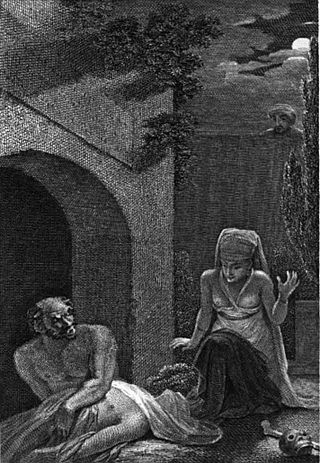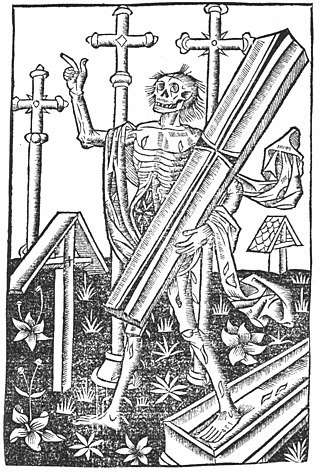The draugr or draug is an undead creature from the Scandinavian saga literature and folktales.

The undead are beings in mythology, legend, or fiction that are deceased but behave as if they were alive. A common example of an undead being is a corpse reanimated by supernatural forces, by the application of either the deceased's own life force or that of a supernatural being. The undead may be incorporeal (ghosts) or corporeal.

A vampire is a mythical creature that subsists by feeding on the vital essence of the living. In European folklore, vampires are undead humanoid creatures that often visited loved ones and caused mischief or deaths in the neighbourhoods which they inhabited while they were alive. They wore shrouds and were often described as bloated and of ruddy or dark countenance, markedly different from today's gaunt, pale vampire which dates from the early 19th century.

Vampire literature covers the spectrum of literary work concerned principally with the subject of vampires. The literary vampire first appeared in 18th-century poetry, before becoming one of the stock figures of gothic fiction with the publication of Polidori's The Vampyre (1819), which was inspired by the life and legend of Lord Byron. Later influential works include the penny dreadful Varney the Vampire (1847); Sheridan Le Fanu's tale of a lesbian vampire, Carmilla (1872), and the most well known: Bram Stoker's Dracula (1897). Some authors created a more "sympathetic vampire", with Varney being the first, and more recent examples such as Moto Hagio's series The Poe Clan (1972–1976) and Anne Rice's novel Interview with the Vampire (1976) proving influential.

A jiāngshī, also known as a Chinese hopping vampire, is a type of undead creature or reanimated corpse in Chinese legends and folklore. Due to the influence of Hong Kong cinema, it is typically depicted in modern popular culture as a stiff corpse dressed in official garments from the Qing dynasty. Although the pronunciation of jiangshi varies in different East Asian countries, all of them refer to the Chinese version of vampire.

Burial, also known as interment or inhumation, is a method of final disposition whereby a dead body is placed into the ground, sometimes with objects. This is usually accomplished by excavating a pit or trench, placing the deceased and objects in it, and covering it over. A funeral is a ceremony that accompanies the final disposition. Evidence suggests that some archaic and early modern humans buried their dead. Burial is often seen as indicating respect for the dead. It has been used to prevent the odor of decay, to give family members closure and prevent them from witnessing the decomposition of their loved ones, and in many cultures it has been seen as a necessary step for the deceased to enter the afterlife or to give back to the cycle of life.

In folklore, a ghoul is a demon-like being or monstrous humanoid, often associated with graveyards and the consumption of human flesh. In the legends or tales in which they appear, a ghoul is far more ill-mannered and foul than the commonly mistaken goblin. The concept originated in pre-Islamic Arabian religion. Modern fiction often uses the term to label a specific kind of monster.
Strigoi in Romanian mythology are troubled spirits that are said to have risen from the grave. They are attributed with the abilities to transform into an animal, become invisible, and to gain vitality from the blood of their victims. Bram Stoker's Dracula may be a modern interpretation of the Strigoi through their historic links with vampirism.

Crataegus monogyna, known as common hawthorn, one-seed hawthorn, or single-seeded hawthorn, is a species of flowering plant in the rose family Rosaceae. It is native to Europe, northwestern Africa, and Western Asia, but has been introduced in many other parts of the world.
In Balkan folklore, a dhampir is a mythical creature that is the result of a union between a vampire and a human. This union was usually between male vampires and female humans, with stories of female vampires mating with male humans being rare.

In folklore, a revenant is a spirit or animated corpse that is believed to have been revived from death to haunt the living. The word revenant is derived from the Old French word revenant'returning'.
A vrykolakas, is a harmful undead creature in Greek folklore. Similar terms such as vourkolakas (βουρκόλακας), vourvoulakas (βουρβούλακας), vorvolakas (βορβόλακας), vourvolakas (βουρβόλακας), vourdoulakas (βουρδούλακας) were also used for the creature.

The Churel, also spelled as Charail, Churreyl, Chudail, Chudel, Chuṛail, Cuḍail or Cuḍel, also known as Petni and Shakchunni, is a mythical or legendary creature resembling a woman, which may be a demoniacal revenant said to occur in South Asia and Southeast Asia, particularly popular in India, Bangladesh, Nepal and Pakistan. The churel is typically described as "the ghost of an unpurified living thing", but because she is often said to latch on to trees, she is also called a tree-spirit. According to some legends, a woman who dies very cruely will come back as a revenant churel for revenge, particularly targeting the males in her family.
The Highgate Vampire was a media sensation surrounding reports of supposed supernatural activity at Highgate Cemetery in London, England, United Kingdom, in the 1970s. The most thorough account of the story is given by folklorist Bill Ellis in the journal Folklore, published in 1993.
Mullo is an undead, revenant, or vampire of Roma folklore. 'Mullo' means 'one who is dead'.

Legends of vampires have existed for millennia; cultures such as the Mesopotamians, Hebrews, ancient Greeks, and Romans had tales of demonic entities and blood-drinking spirits which are considered precursors to modern vampires. Despite the occurrence of vampire-like creatures in these ancient civilizations, the folklore for the entity known today as the vampire originates almost exclusively from early 18th-century Central Europe, particularly Transylvania as verbal traditions of many ethnic groups of the region were recorded and published. In most cases, vampires are revenants of evil beings, suicide victims, or witches, but can also be created by a malevolent spirit possessing a corpse or a living person being bitten by a vampire themselves. Belief in such legends became so rife that in some areas it caused mass hysteria and even public executions of people believed to be vampires.
The talamaur is a vampire legend of the Banks Islands, Vanuatu, located in the South Pacific. A talamaur was a type of vampire who controlled the ghost of a dead person, and could use it to drain the vitality from the living and the recently deceased. Some people actually aspired to become talamaurs. The power of a talamaur could purportedly be gained by eating part of a corpse, thus gaining kinship with the soul of the deceased.
Chedipe is a witch-vampire in the folklore of the region around the Godavari River in India. They are associated with the betals,. Women who die an unnatural death, such as in childbirth or by suicide, and prostitutes may become chedipes. Chedipes are sometimes characterized as being undead.
The Lord Ruthven Award is an annual award presented by the Lord Ruthven Assembly, a group of academic scholars specialising in vampire literature and affiliated with the International Association for the Fantastic in the Arts (IAFA).

Upiór (Tatar language: Убыр , Turkish: Ubır, Obur, Obır, is a demonic being from Slavic and Turkic folklore, a prototype of the vampire. It is suggested that the ubır belief spread across the Eurasian steppes through the migrations of the Kipchak-Cuman people, after having its origins in the regions surrounding the Volga River and the Pontic steppes. The modern word "vampire" derives from the Old Slavic language and Turkic form онпыр , with the addition of the sound "v" before a large nasal vowel, characteristic of Old Bulgarian, as evidenced by the traditional Bulgarian form впир.










